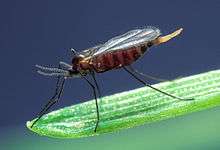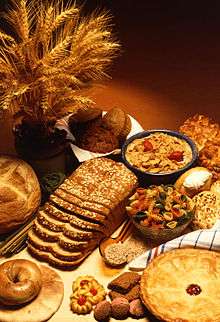Hessian fly
The Hessian fly or barley midge, Mayetiola destructor, is a species of fly that is a significant pest of cereal crops including wheat, barley and rye. Though a native of Asia it was transported into Europe and later into North America, supposedly in the straw bedding of Hessian troops during the American Revolution (1775–83), thus the origin of its common name. There are usually two generations a year but may be up to five. In the spring the dark-coloured female lays about 250 to 300 reddish eggs on plants, usually where the stems are covered by leaves; the larvae feed on the sap and weaken the plants so that they cannot bear grain.
| Hessian fly | |
|---|---|
 | |
| Scientific classification | |
| Kingdom: | |
| Phylum: | |
| Class: | |
| Order: | |
| Family: | |
| Genus: | |
| Species: | M. destructor |
| Binomial name | |
| Mayetiola destructor (Say, 1817) | |
| Synonyms | |
|
Cecidomyia destructor Say, 1817 | |
The Hessian fly was described by Thomas Say in 1817. It is a very harmful insect. It mainly attacks the stem, although if it is especially hungry it will eat any part of the plant it can find.
In 1836, a severe infestation of Hessian flies resulted in a crop shortage aggravating the financial problems of farmers prior to the Panic of 1837.[1]
References
- McGrane, Reginald Charles. (1924, 1965) The Panic of 1837: Some Financial Problems of the Jackson Era. New York: Russell & Russell Inc.
